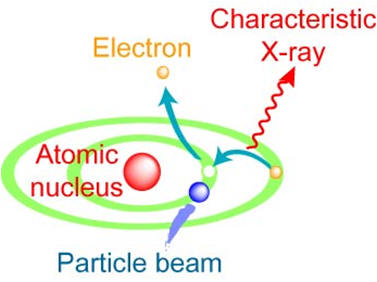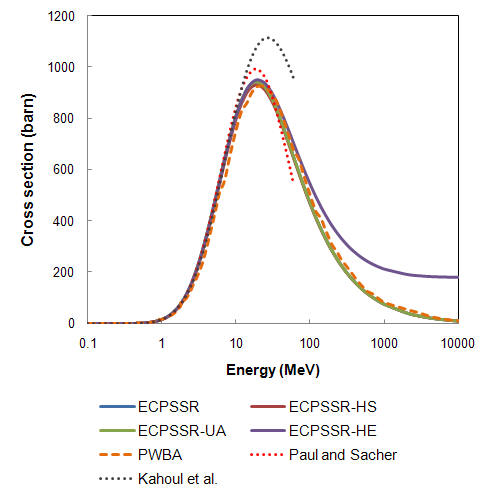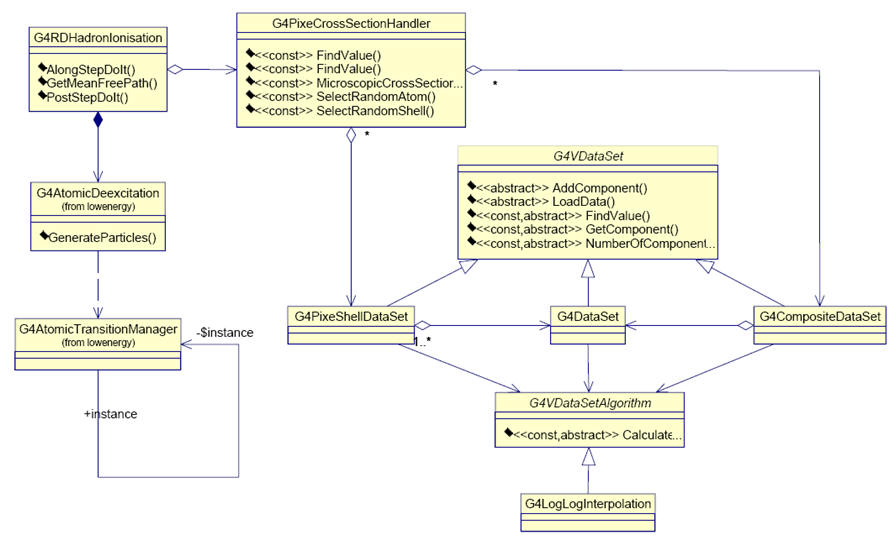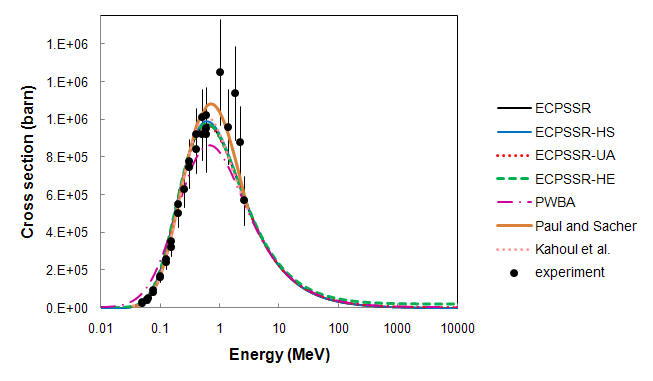
PIXE simulation with Geant4
M. G. Pia, G. Weidenspointner, M. Augelli, L. Quintieri, P. Saracco, M. Sudhakar, A. Zoglauer,
PIXE simulation with Geant4
IEEE Trans. Nucl. Sci., vol. 56, no. 6, pp. 3614-3649, Dec. 2009
 |
PIXE simulation with Geant4 |
|
Reference:
M. G. Pia, G. Weidenspointner, M. Augelli, L. Quintieri, P. Saracco, M. Sudhakar, A. Zoglauer, PIXE simulation with Geant4 IEEE Trans. Nucl. Sci., vol. 56, no. 6, pp. 3614-3649, Dec. 2009 |
 |
PIXE stands for Particle Induced X-ray Emission. The origin of the emission lies in the ionization of target material atoms by incident energetic charged particles. Some atoms are ionized by removing an electron from an inner electronic shell; this inner shell vacancy is subsequently filled by an electron from an outer shell. Such an electron transition may give rise to the emission of characteristic X-rays at energies corresponding to the difference in the binding energies of the involved atomic shells. PIXE is exploited as an experimental technique to determine the elemental composition of a material sample. |
Despite the simplicity of its nature as a physical effect, PIXE represents a conceptual challenge for general-purpose Monte Carlo codes, since it involves an intrinsically discrete effect (the atomic relaxation) intertwined with a process (ionisation) affected by infrared divergence. The largely incomplete knowledge of ionization cross sections by hadron impact, limited to the innermost atomic shells both as theoretical calculations and experimental measurements, further complicates the achievement of a conceptually consistent description of this process.
A variety of cross sections models for the ionization of K, L and M shells by protons and
alpha particles are available in Geant4:The calculation of cross sections is based on the interpolation of tabulated values, which are collected in a data library. The tabulations corresponding to theoretical calculations span the energy range between 10 keV and 10 GeV; empirical models are tabulated consistently with the energy range of validity documented by their authors.
ECPSSR tabulations have been generated using the ISICS software, 2006 version; an extended version, kindly provided by ISICS author S. Cipolla, has been exploited to produce tabulations associated with recent high energy modeling developments.
Further details are extensively discussed in PIXE simulation with Geant4.
Geant4 provides functionality to simulate PIXE based on the physics models and software described in this page and documented in detail in PIXE simulation with Geant4.
The Geant4 G4hImpactIonisation process deals with ionisation by impact of hadrons and alpha particles, and the following generation of PIXE (Particle Induced X-ray Emission). It provides users the option to choose among various cross section models for the ionisation of K, L and M shells:
| Cross section models for protons |
An example Cross section for copper K shell ionisation by protons according to different models |
||
| K shell | L shell | M shell | |
| ECPSSR | ECPSSR | ECPSSR | |
| ECPSSR (with Hartree-Slater correction) | ECPSSR (with "united atom" approximation) | PWBA | |
| ECPSSR (with "united atom" approximation) | PWBA | ||
| ECPSSR (with high energy correction) | Miyagawa et al. | ||
| Plane Wave Born Approximation (PWBA) | Orlic et al.. | ||
| Paul and Sacher | Sow et al. | ||
| Kahoul et al. | |||
| Cross section models for alpha particles | |||
| K shell | L shell | M shell | |
| ECPSSR | ECPSSR | ECPSSR | |
| ECPSSR (with Hartree-Slater correction) | PWBA | PWBA | |
| Plane Wave Born Approximation (PWBA) | |||
| Paul and Bolik | |||
An example of how to use this process is shown here. A more extensive example is available in the eRosita Geant4 example (in examples/advanced/eRosita).
In the current Geant4 release the implementation of the hadron impact ionisation process (G4ImpactIonisation) is largely based on the original G4hLowEnergyIonisation process. Thanks to the adopted component-based software design, the simulation of PIXE curently exploits the existing Geant4 atomic relaxation component to produce secondary X-rays resulting from impact ionization.
The software is released in Geant4 9.4. These developments are part of the INFN NANO5 project.

 |
An example Cross section for the ionization of carbon K shell by proton impact according to the various implemented modeling options, and comparison with experimental data derived from Paul and Sacher. The curves reproducing some of the model implementations can be hardly distinguished in the plot due to their similarity. |
The implemented cross section models have been subject to rigorous statistical analysis to evaluate their compatibility with experimental measurements and to compare the relative accuracy of the various modeling options. The validation process involved two stages: first goodness-of-fit analysis based on the
chisquare test to evaluate the hypothesis of compatibility with experimental data, then categorical analysis exploiting contingency tables to determine whether the various modeling options differ significantly in accuracy.The complete set of validation results is documented in PIXE simulation with Geant4; only the main ones are summarized here.
Regarding the K shell, the statistical analysis identified the ECPSSR model with Hartree-Slater correction as the most accurate in the energy range up to approximately 10 MeV; at higher energies the ECPSSR model in its plain formulation or the empirical Paul and Sacher one (within its range of applicability) exhibit the best performance. The scarceness of high energy data prevents a definitive appraisal of the ECPSSR specialization for high energies.
Regarding the L shell, the ECPSSR model with “united atom” approximation exhibits the best accuracy among the various implemented models; its compatibility with experimental measurements at 95% confidence level ranges from approximately 90% of the test cases for the L3 sub-shell to approximately 65% for the L1 sub-shell. According to the results of the categorical analysis, the ECPSSR model in its original formulation can be considered an equivalently accurate alternative. The Orlic et al. model exhibits the worst accuracy with respect to experimental data; its accuracy is significantly different from the one of the ECPSSR model in the united atom variant.
The ionisation cross sections used by the process are tabulated in the PIXE Data Library, which is planned to be distributed by RSICC.
A copy of the data library especially adapted for use with Geant4 is distributed with Geant4 as the G4PII data set. The GPII data set must be downloaded along with Geant4 source code.
The Geant4 G4PII data set is associated with the G4PIIDATA environment variable; to use this data library in the simulation, the environment variable should be defined to point to the location where the G4PII data set has been downloaded:
The G4PIIDATA environment variable must be defined to refer to the location of the G4PII PIXE data library in the file system; for instance, in a c-like shell:
setenv G4PIIDATA path_to_where_G4PII_has_been_downloaded
The PIXE software described here has been successfully applied to the
optimization of the graded shielding of the
eROSITA
mission.
A simplified version of the eROSITA simulation is available as the Geant4
eRosita advanced example; it has
been developed by the eROSITA team at the
Max-Planck-Institut Halbleiterlabor.